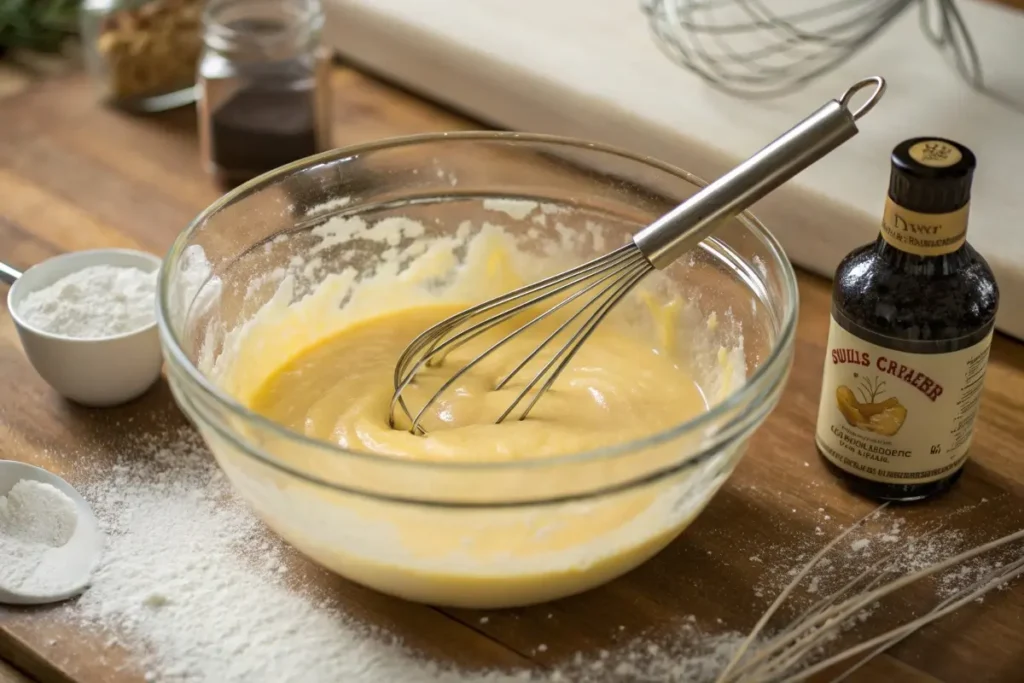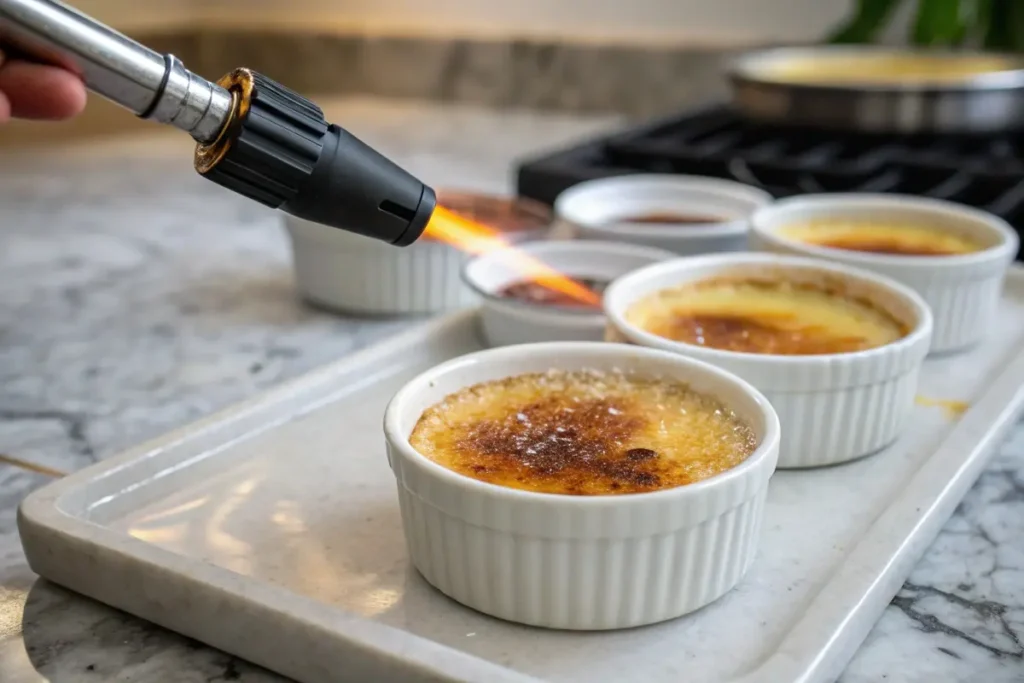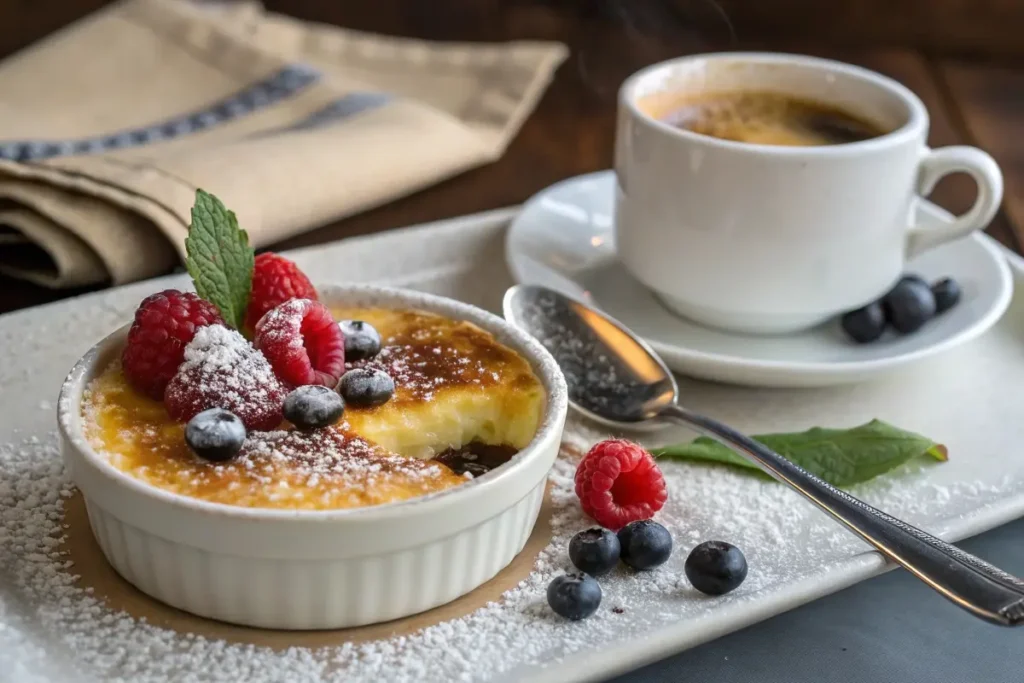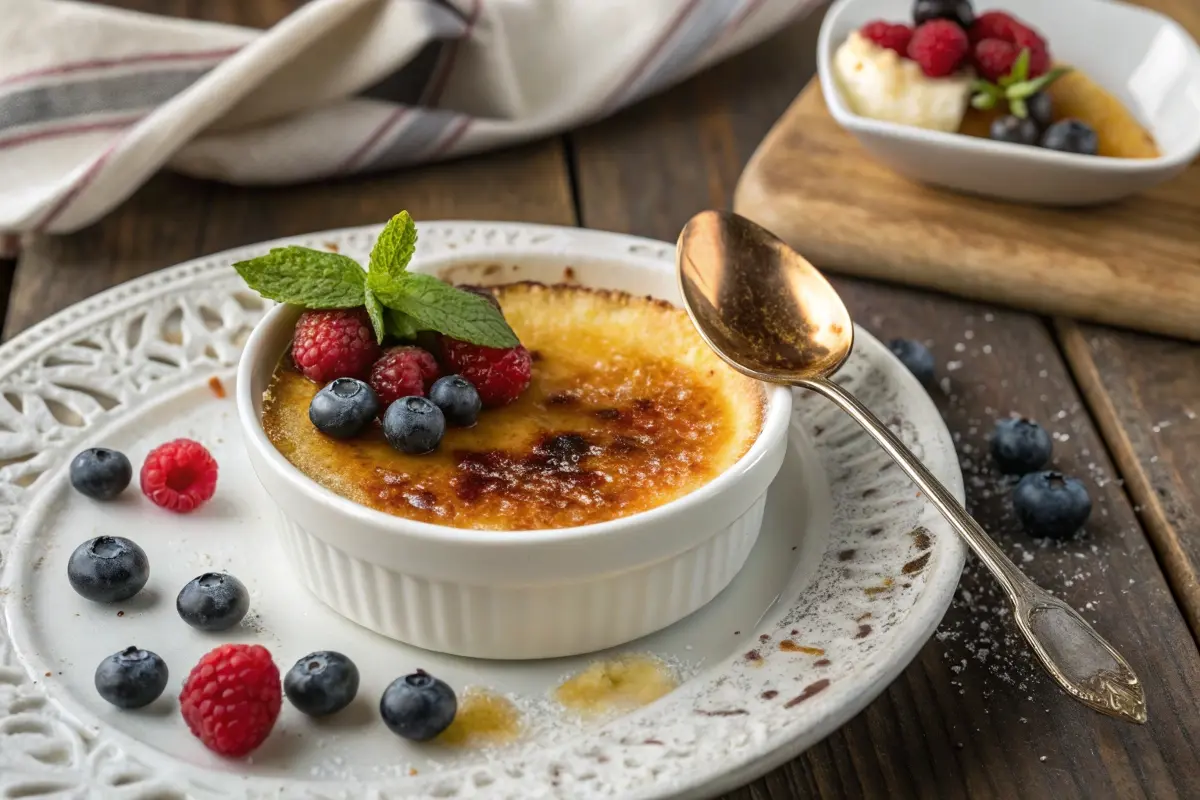Few desserts capture elegance and simplicity quite like crème brûlée. With its silky custard base and crisp caramelized sugar topping, this classic French dessert is a true masterpiece. But what is the secret of crème brûlée? How do you achieve that perfectly smooth custard, the glass-like sugar crust, and the delicate balance of flavors?
In this guide, we’ll break down everything you need to know about crème brûlée, from its history and essential ingredients to expert techniques and troubleshooting tips. Whether you’re making it for the first time or refining your skills, this guide will help you unlock the secrets to the perfect crème brûlée.
Let’s dive into the magic of this beloved dessert!
Table of Contents
Introduction to Crème Brûlée
What is Crème Brûlée?
At its core, crème brûlée is a rich, baked custard with a thin, crisp layer of caramelized sugar on top. The name itself means “burnt cream” in French, referring to the torched sugar crust that adds a delightful crunch to each spoonful.
The custard is typically made with heavy cream, egg yolks, sugar, and vanilla, creating a velvety texture that melts in your mouth. After chilling, a layer of sugar is sprinkled over the surface and caramelized using a kitchen torch or broiler, resulting in the dessert’s signature golden topping.
The History of This Classic French Dessert
Though it’s widely known as a French delicacy, crème brûlée has a fascinating history. Some believe it originated in England as “burnt cream,” while others trace it back to Catalan cuisine, where a similar dessert called crema catalana is popular.
However, it was in 17th-century France that crème brûlée truly gained recognition, particularly in the kitchens of the Palace of Versailles. Over time, it became a staple in fine dining and remains a timeless favorite on restaurant menus worldwide.
Why Crème Brûlée Remains a Timeless Favorite
So, why does crème brûlée continue to captivate dessert lovers?
- Simple yet sophisticated – It’s easy to make but feels luxurious.
- The contrast of textures – Silky custard meets crispy caramelized sugar.
- Customizable flavors – From classic vanilla to chocolate, coffee, or fruit-infused variations, crème brûlée offers endless possibilities.
The Essential Ingredients for Perfect Crème Brûlée
What is the secret of crème brûlée? It all starts with the right ingredients. Each component plays a crucial role in achieving the perfect balance of creamy custard and crisp caramelized sugar.
Choosing the Right Dairy: Heavy Cream vs. Milk
The base of a great crème brûlée is rich and silky custard, and that comes from heavy cream. Some recipes use a mix of cream and milk, but for the best texture, stick with heavy cream. It provides a smooth, velvety mouthfeel that makes each bite pure indulgence.
If you prefer a lighter version, you can substitute up to ¼ of the cream with whole milk—but avoid using skim milk, as it lacks the fat needed for a luxurious custard.
Egg Yolks: The Key to a Smooth Custard
Egg yolks give crème brûlée its structure and creamy texture. They act as a natural thickener, creating a custard that is firm yet soft enough to melt in your mouth.
- Use large, fresh egg yolks for the best results.
- Avoid using too many egg whites, as they can make the custard rubbery.
The Best Sugar for Caramelization
For that perfectly crisp sugar topping, granulated white sugar works best. It caramelizes evenly and forms the classic golden crust that cracks beautifully with a spoon.
Vanilla and Other Flavor Enhancements
The classic crème brûlée is flavored with pure vanilla extract or vanilla bean for a deep, aromatic taste. However, you can also experiment with coffee, citrus zest, or liqueurs for unique variations.
Now that we’ve covered the ingredients, let’s explore the science behind making the perfect custard.
The Science Behind the Perfect Custard
What is the secret of crème brûlée? Beyond the ingredients, technique matters just as much. Understanding the science behind custard-making will help you achieve a smooth, creamy, and flawless dessert every time.
The Role of Low and Slow Baking
Custard is delicate, so baking at a low temperature is essential. If the oven is too hot, the eggs will cook too quickly, leading to a grainy or scrambled texture.
- Bake at 300°F (150°C) for 30–40 minutes for even cooking.
- The custard should be set around the edges but slightly wobbly in the center—it will continue to firm up as it cools.
Why a Water Bath is Essential
A bain-marie, or water bath, is a must for crème brûlée. It keeps the custard temperature stable and prevents overheating.
- Place the ramekins in a deep baking dish and pour hot water halfway up the sides.
- This gentle heat ensures a smooth, creamy texture without curdling.
Preventing Curdling: How to Avoid Overheating

If you’ve ever had crème brûlée with a lumpy or scrambled texture, overheating is likely to blame. To prevent this:
- Gently heat the cream before adding it to the egg yolks—this helps prevent temperature shock.
- Temper the eggs by gradually whisking the warm cream into them, ensuring a smooth mixture.
Straining the Custard for a Velvety Texture
For silky-smooth crème brûlée, always strain the custard through a fine-mesh sieve before baking. This removes any bits of cooked egg and ensures the final dessert is creamy without lumps.
Mastering the custard is key, but the real magic happens in the caramelized sugar topping—let’s explore that next!
The Secret to the Perfect Crème Brûlée Caramelization
Choosing the Best Sugar for the Crispy Top
The secret to a perfect crème brûlée lies in the caramelized sugar crust. But not all sugars caramelize the same way.
- Granulated white sugar: The best choice for even caramelization and a delicate crunch.
- Superfine sugar: Melts quickly and forms an ultra-thin layer, great for a glass-like effect.
- Brown sugar: Can be used for a deeper, caramel-like flavor but may burn faster.
For the best results, sprinkle an even layer of sugar over the custard before caramelizing. This ensures uniform melting and prevents burnt spots.
The Right Torch Technique for Even Caramelization

Using a kitchen torch is the best way to achieve that signature golden-brown crust. Follow these steps:
- Hold the torch at a 45-degree angle, about 2 inches away from the surface.
- Move the flame in a circular motion to heat the sugar evenly.
- Watch for color changes—it should turn golden brown, not black.
- Let it sit for 1-2 minutes before serving to allow the caramel to harden.
Alternative Methods: Using the Oven Broiler
Don’t have a torch? No problem! You can use the oven broiler instead:
- Set the broiler to high and place the ramekins on the top rack.
- Watch closely! Sugar caramelizes fast and can burn in less than a minute.
- Rotate the ramekins if necessary for even caramelization.
How to Achieve the Signature Crack Without Burning
The secret to getting that satisfying sugar crack when tapping with a spoon?
- Use a thin, even sugar layer—too thick, and it won’t break easily.
- Caramelize the sugar right before serving to maintain the crispy texture.
Now that your caramelized topping is perfect, let’s go over common mistakes and how to fix them.
Common Mistakes and How to Fix Them
Why is My Custard Too Runny or Too Firm?
A wobbly custard is normal, but if it’s too runny or too stiff, something went wrong.
- Runny custard? It might be undercooked. Bake it for a few extra minutes until the edges are set.
- Too firm? You may have overcooked it, causing the eggs to curdle. Next time, check for doneness earlier.
Avoiding a Grainy or Scrambled Texture
If your crème brûlée turns out grainy instead of smooth, it’s likely due to overheated eggs.
How to fix it:
- Always temper the eggs by slowly whisking in warm cream.
- Bake in a water bath to regulate heat and prevent curdling.
How to Prevent the Sugar Layer from Melting Too Soon
Sometimes, the crispy caramel layer starts to melt into the custard. Here’s why:
- The custard was too warm when you caramelized the sugar. Always chill it for at least 2 hours before torching.
- The sugar layer was too thick. Use just a thin, even coating to avoid a sticky mess.
Fixing Uneven Caramelization
Burnt patches? Spotty caramel? Here’s what to do:
- Hold the torch further away to prevent scorching one area too quickly.
- Keep the flame moving constantly for an even golden-brown layer.
With these fixes, you’ll avoid common pitfalls and make flawless crème brûlée every time! Now, let’s explore some creative flavor variations.
Creative Variations of Crème Brûlée
When people ask, what is the secret of crème brûlée, they often assume there’s only one way to make it. However, the beauty of this classic dessert is its versatility. While the traditional vanilla version is undeniably delicious, you can experiment with flavors, textures, and even dietary adaptations to create something unique!
Chocolate Crème Brûlée: A Decadent Twist
For chocolate lovers, this variation is a must-try. Simply:
- Melt 3 ounces of dark chocolate into the cream before mixing with the egg yolks.
- Reduce the sugar slightly to balance the richness of the chocolate.
- Follow the same baking and caramelizing process for a silky, indulgent twist.
This version tastes like a fusion of chocolate mousse and classic crème brûlée—pure heaven!
Fruit-Infused Crème Brûlée: Raspberry, Lemon, and More
Adding fruit flavors can brighten up the creamy custard. Try these ideas:
- Raspberry Crème Brûlée: Blend fresh raspberries into the cream before baking.
- Lemon or Orange Zest Crème Brûlée: Add citrus zest to the cream for a refreshing zing.
- Coconut Crème Brûlée: Replace half of the heavy cream with coconut milk for a tropical touch.
Dairy-Free and Vegan Crème Brûlée Options
You can still enjoy this dessert without dairy or eggs! Substitute:
- Full-fat coconut milk instead of heavy cream.
- Cornstarch and plant-based milk to thicken instead of egg yolks.
- Maple syrup or agave for natural sweetness.
Liqueur-Infused Crème Brûlée for an Elevated Flavor
For a sophisticated twist, add a splash of Baileys, Grand Marnier, or Amaretto to the custard before baking. These liqueurs enhance the richness without overpowering the delicate custard.
Frequently Asked Questions (FAQ)
Many home bakers ask, what is the secret of crème brûlée? To make things easier, we’ve gathered the most frequently asked questions about this delicate dessert.
Can I Make Crème Brûlée Without a Torch?
Yes! While a kitchen torch is the best tool, you can also caramelize the sugar using an oven broiler:
- Set your broiler to high and place the ramekins on the top rack.
- Watch carefully—sugar can burn within 30–60 seconds.
- Rotate the ramekins as needed for even caramelization.
How Long Does Crème Brûlée Need to Chill?
For the best texture, crème brûlée should chill for at least 2 hours, but overnight is even better. Chilling allows the custard to firm up and develop deeper flavors.
Can I Make Crème Brûlée Ahead of Time?
Absolutely! You can prepare and bake the custard up to 2 days in advance. Just cover and refrigerate, then caramelize the sugar right before serving for the best crackly top.
What’s the Best Way to Store Leftover Crème Brûlée?
If you have leftovers (which is rare!), store them covered in the fridge for up to 3 days. However, note that the caramelized sugar topping will soften over time, so it’s best to eat fresh.
How Do I Get a Perfectly Smooth Custard?
For that luxuriously smooth texture, always:
- Strain the custard before baking.
- Bake in a water bath for gentle, even cooking.
- Avoid overbaking—the center should still be slightly jiggly when removed from the oven.
With these expert answers, you’re now fully equipped to master the art of crème brûlée!
Conclusion and Final Thoughts
Mastering the Secret to the Best Crème Brûlée
So, what is the secret of crème brûlée? It’s a combination of quality ingredients, precise technique, and a bit of patience. The key lies in using rich heavy cream, tempering the egg yolks properly, baking at a low temperature, and caramelizing the sugar just right. Whether you stick with the classic vanilla version or experiment with creative flavors, getting these basics right will always lead to a perfect dessert.
Beyond technique, the true magic of crème brûlée is in the contrast of textures—a silky custard beneath a crisp caramelized top. When you hear that satisfying crack as your spoon breaks through the golden sugar layer, you know you’ve nailed it!
Share Your Crème Brûlée Creations with Us!

Now that you know the secret of crème brûlée, it’s time to put your skills to the test! Try out the recipe, experiment with flavors, and enjoy every spoonful of this luxurious dessert.
We’d love to see your results! Tag us on social media with your crème brûlée creations using the hashtag #CremeBruleeSecrets.
More French Dessert Recipes to Try
Craving more classic French treats? Try making chocolate soufflé, tarte tatin, or éclairs next!
Happy baking, and enjoy your perfect crème brûlée! 😊🍮

